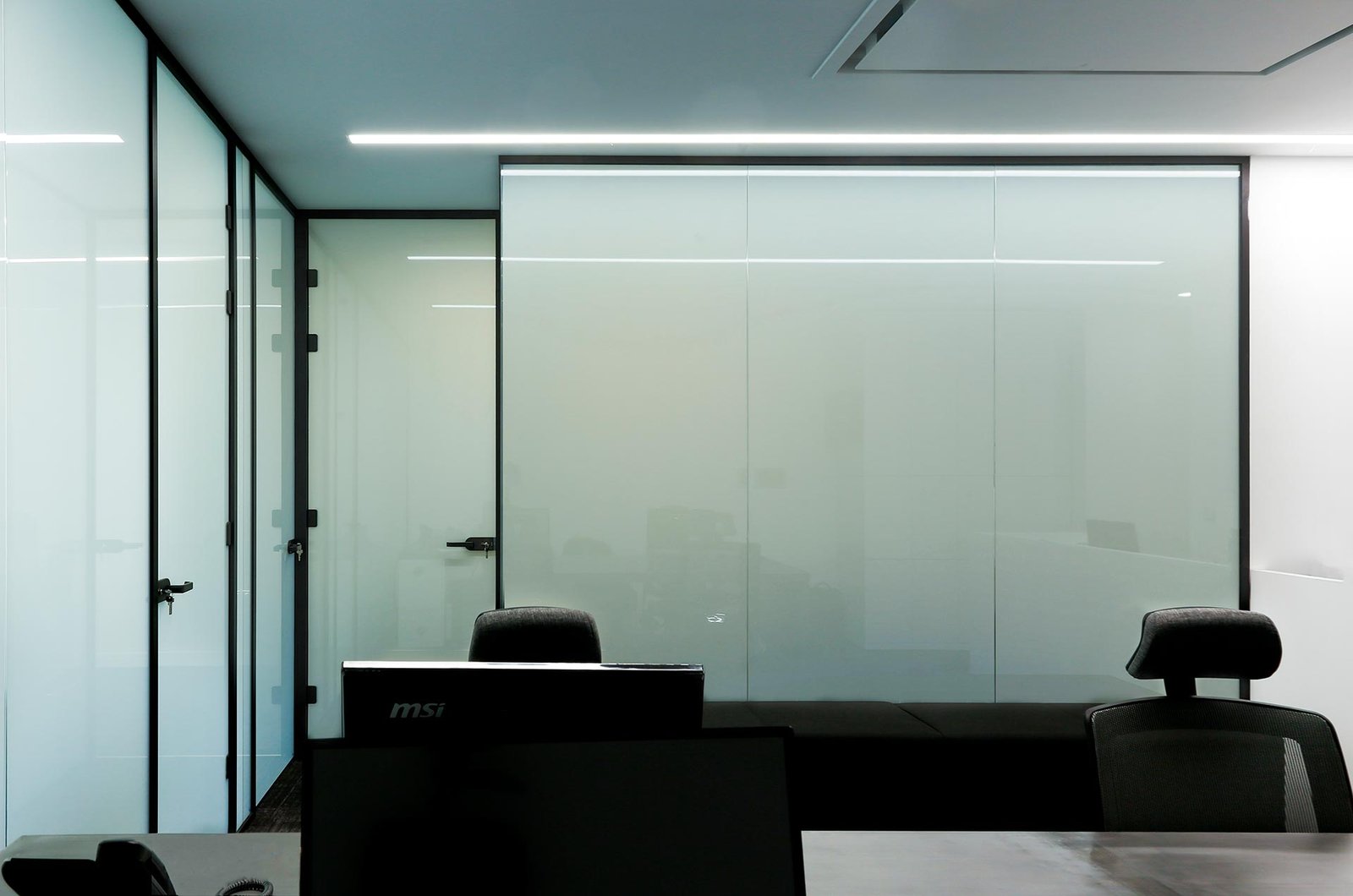
Blog
The Importance of Smart Glass in Modern Office Interior Design

In today’s dynamic corporate environment, office design goes beyond aesthetics. It has become a tool for enhancing productivity, collaboration, and employee well-being. One of the most transformative innovations in this domain is smart glass technology, specifically switchable privacy glass. This article explores the significance of smart glass in office interiors and how it meets the modern demands of functionality, flexibility, and elegance.
Table of Contents
What is Smart Glass?
Smart glass, also known as switchable glass, is a glazing solution that can change its transparency from clear to opaque with the flick of a switch or via automation. The technology utilises liquid crystals or electrochromic materials, enabling glass to offer privacy on demand while still allowing light transmission.
Why Interior Design Matters in the Workplace
The design of an office plays a pivotal role in shaping organisational culture, employee productivity, and client impressions. Companies are increasingly moving away from traditional cubicles to create collaborative, open, and adaptable workspaces. Smart glass offers an ideal solution by aligning with key design principles:
- Flexibility: Modern offices require multi-functional spaces that can adapt to changing needs.
- Light Optimisation: Natural light boosts mood and productivity.
- Aesthetics: Sleek and minimalistic designs dominate current trends.
The Role of Smart Glass in Office Design
1. Enhanced Privacy Without Compromising Openness
Traditional methods of ensuring privacy, like blinds or curtains, can feel bulky and outdated. Smart glass offers a seamless way to switch between open spaces and private zones, whether for confidential meetings or focused work. This dual functionality creates a versatile office environment.
2. Improved Energy Efficiency
Smart glass can reduce energy consumption by controlling the heat and light entering a room. In opaque mode, it reduces solar glare and heat gain, minimizing the need for air conditioning. Similarly, clear glass maximises daylight use, reducing artificial lighting costs.
3. Boosted Aesthetic Appeal
The sleek and modern appearance of smart glass aligns perfectly with contemporary design trends. It adds a futuristic touch to office interiors, appealing to both employees and visitors.
4. Acoustic Control
Smart glass can also offer soundproofing benefits, making it ideal for conference rooms or executive offices where confidentiality and quiet are essential.
5. Health and Well-Being
Access to natural light has been proven to improve employee health, reduce stress, and enhance concentration. Smart glass maximises daylight while offering privacy when needed, striking a balance between openness and focus.
Applications of Smart Glass in Offices
1. Conference Rooms
Smart glass transforms conference rooms into private spaces for discussions and presentations at the push of a button. Its ability to switch between transparency and opacity ensures privacy without blocking natural light.
2. Partitions
Glass partitions with smart technology are a popular choice in open-plan offices. They provide a flexible way to create separate spaces for focused work, collaboration, or relaxation.
3. Windows and Skylights
Using smart glass for windows enhances the overall energy efficiency of a building. It also helps regulate indoor temperatures, making the office more comfortable for employees.
4. Reception Areas
First impressions matter. Smart glass in reception areas can create a dynamic and welcoming environment while maintaining privacy where necessary.
Environmental Benefits of Smart Glass
- Energy Conservation
- By controlling heat gain and light transmission, smart glass reduces reliance on HVAC systems and artificial lighting.
- Sustainability
- Smart glass contributes to green building certifications such as LEED, reflecting a company’s commitment to environmental responsibility.
- Durability
- High-quality smart glass is designed for longevity, reducing the need for frequent replacements and waste generation.
Incorporating Smart Glass in Your Office Design: Best Practices
1. Understand Your Needs
Identify areas where privacy, light control, or flexibility is most important, such as meeting rooms or executive offices.
2. Work with Experts
Collaborate with architects and interior designers who have experience with smart glass technology to ensure seamless integration into your office layout.
3. Leverage Automation
Pair smart glass with automated systems for optimised performance. For example, schedule opacity changes based on time of day or sunlight intensity.
4. Focus on Aesthetics
Choose smart glass that complements your office’s colour palette and design elements to maintain a cohesive look.
Challenges and Considerations
While smart glass offers numerous benefits, there are a few considerations:
- Initial Costs
The upfront investment in smart glass can be higher than traditional solutions. However, long-term energy savings and durability often justify the expense. - Maintenance
Proper cleaning and occasional servicing are necessary to maintain the performance and appearance of smart glass. - Integration
Seamless integration with existing systems, such as lighting or HVAC, requires careful planning.
FAQs
What is the Lifespan of Smart Glass?
High-quality smart glass typically lasts over 10 years with proper maintenance.
Can Smart Glass Be Customised?
Yes, it can be tailored in size, shape, and even colour to suit your design preferences.
Is Smart Glass Eco-friendly?
Absolutely! Its energy-saving features and contribution to sustainable design make it an eco-conscious choice.
How Does Smart Glass Impact Employee Productivity?
By optimising natural light and privacy, smart glass creates an environment conducive to focus, creativity, and collaboration.
Conclusion
Smart glass is revolutionising office interior design by combining functionality, aesthetics, and sustainability. It caters to the demands of modern workplaces, offering flexibility, energy efficiency, and a contemporary edge. By incorporating smart glass into your office, you create a dynamic environment that supports productivity, well-being, and innovation.
Whether you’re designing a new office or renovating an existing space, smart glass is a future-ready investment that aligns with both corporate and environmental goals.